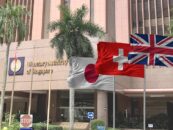
MAS Unveils Five New Industry Pilots Under Project Guardian
by Fintech News Singapore November 15, 2023The Monetary Authority of Singapore (MAS) has teamed up with the financial industry to expand initiatives related to asset tokenisation.
The goal is to enhance the foundational capabilities necessary to scale tokenised markets, ultimately driving institutional adoption of digital assets.
These efforts, part of Project Guardian, free up liquidity, unlock investment opportunities, and improve the efficiency of financial markets.
Under Project Guardian, a group of 17 financial institutions (FIs) is undertaking five new industry pilots to test promising asset tokenisation use cases.
What you need to know about the new industry pilots
In the first pilot, Citi, T. Rowe Price, and Fidelity International are testing institutional-grade mechanisms to price and execute bilateral digital asset trades.
Meanwhile, BNY Mellon and OCBC are trialling a cross-border FX payment solution to enable secure, interoperable payment solutions across heterogenous networks.
For the third pilot, Ant Group is trialing a treasury management solution to enhance liquidity management funding globally. This solution will enable real-time multi-currency clearing and settlement through their global treasury centre in Singapore which supports over 40 currencies.
In addition to that, Franklin Templeton is exploring the issuance of a tokenised money market fund through a Variable Capital Company (VCC) structure, which utilises digital asset networks to maintain the records of fund shares. It is worth noting that a new funds workstream is being launched within the Project Guardian industry group to focus on the native issuance of VCC funds on digital asset networks. MAS will work with the Accounting and Corporate Regulatory Authority (ACRA) on this.
Lastly, J.P. Morgan and Apollo are collaborating on the use of digital assets to enable more seamless investment and management of discretionary portfolios and alternative assets.
MAS’ digital infrastructure initiatives for Project Guardian
Additionally, MAS is collaborating with international policymakers and financial institutions like BNY Mellon, DBS, JP Morgan, and MUFG to create an open digital infrastructure called Global Layer One (GL1).
This infrastructure will facilitate seamless cross-border transactions and enable trading of tokenised assets across global liquidity pools while adhering to regulatory requirements.
Furthermore, MAS is working with the financial industry to develop an Interlinked Network Model (INM) as a common framework for exchanging digital assets across independent networks, enabling transactions among financial institutions without the need for all to be on the same network.
International collaboration with regulators
MAS also announced that the International Monetary Fund (IMF) will be joining Project Guardian’s policymaker group.
In a bid to expand the scope of Project Guardian, MAS had established a policymaker group in June which comprises regulators from Japan, Singapore, Switzerland, and the UK.
IMF will provide an international perspective on the policies and legal issues that would facilitate cooperation around cross-border platforms and preserve the stability of the international monetary system.

Leong Sing Chiong
Leong Sing Chiong, Deputy Managing Director (Markets and Development), MAS, said,
“Project Guardian’s industry pilots have successfully demonstrated that tokenised financial assets such as fixed income, foreign exchange and asset management products can be traded, distributed, and settled seamlessly across borders. To fully realise the potential of tokenised markets, and achieve network effects, a scalable digital infrastructure is needed.
GL1 will provide a foundational digital backbone and bring markets together with similar principles of openness and accessibility as the public internet. MAS welcomes additional policymakers and financial institutions to participate in the design phase of the GL1 initiative and contribute towards its development.”






